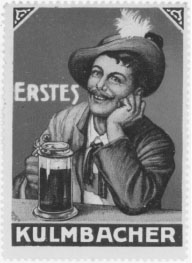Kulmbacher, Germany, a town in the north of Franconia, Bavaria, where beer has played a major role in the town’s economical and social life from the 19th century onward. Since 1996, the local beer scene has been dominated by one major player, “Kulmbacher Brauerei AG,” but history has seen a slow amalgamation of erstwhile independent breweries. Reichelbräu (1846) focused on export and gradually took over all the concurrents. Today’s Kulmbacher Brauerei is owned by the the Schörghuber group with Brau-Holding International (Heineken) and produces 2.2 million hl annually.
At the start of August, the annual Bierwoche (Beerweek) takes place in a big tent in town. Here the erstwhile partition in four major breweries is apparent, even when the former sandlerbräu has been replaced by kapuzinerbräu (wheat beer), whereas once only festbier was available. The other three breweries retain their old names: EKU (Erste Kulmbacher Unionsbräu), Reichelbräu, and Mönchshof. Brewing on an industrial scale is still done at EKU and the former Reichelbräu, with Mönchshof having been reshaped into a brewing museum annex microbrewery. This is apt because the brewing site dates from 1349.

German poster stamp, c. 1920. pike microbrewery museum, seattle, wa
Kulmbacher beer is known throughout the world for two strong specialty beers: Kulminator 28, also known as EKU 28 (referring to the original gravity of 28 degrees Plato), an 11% alcohol by volume doppelbock, at one time the strongest lager in the world, and Kulmbacher Bayrisch G’frorns, a genuine eisbock.
Historical information. Personal communication with Michaela Knoer of the Gesellschaft fur Geschichte des Brauwesens e.V., Berlin. Information on EKU Kulminator. Personal communication with Jonathan Downing.
